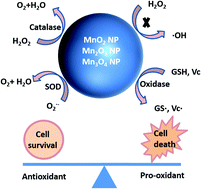Crossover between anti- and pro-oxidant activities of different manganese oxide nanoparticles and their biological implications†
Abstract
Manganese oxide nanoparticles (MnOx NPs) have been suggested to possess several enzyme-like activities. However, studies often used either color change or fluorescence to determine the catalytic activity. Despite the simplicity and sensitivity of these probes, these methods may give distracting artifacts or not reflect the catalytic activities in biological systems. To address this issue, herein, we used electron spin resonance (ESR) spectroscopy, a technique proven effective in identifying and quantifying the free radicals produced/scavenged in nanomaterial-catalyzed reactions, to systematically evaluate the catalytic activities of three MnOx NPs (MnO2, Mn2O3, and Mn3O4 NPs) towards biologically relevant antioxidants (ascorbate and glutathione (GSH)) and reactive oxygen species (ROS) (hydrogen peroxide (H2O2), superoxide anion, and hydroxyl radical). We found that all three MnOx NPs possess both pro- and anti-oxidant activities, including oxidase-, catalase-, and superoxide dismutase (SOD)-like activities but without peroxidase-like or hydroxyl radical scavenging activity. In addition, there are differences among these MnOx NPs in their catalytic activities towards different reactions. Mn2O3 shows the strongest ascorbate oxidation activity, followed by MnO2 and Mn3O4, while Mn3O4 shows the strongest oxidation efficiency towards GSH compared to Mn2O3 and MnO2. In the catalyzed decomposition of H2O2, MnO2 NPs show higher efficiency in the generation of molecular oxygen than Mn2O3 or Mn3O4. Cellular studies indicate that all three MnOx NPs induced concentration-dependent decreases in the cell viability, with Mn3O4 > Mn3O2 > MnO2. At lower concentrations (<100 μM), consistent with the enzyme-like activities detected in solution, all three NPs significantly decreased H2O2-induced cytotoxicity in Caco-2 cells. Our study determined the multi-enzymatic activities of MnOx NPs and exhibited differences among MnOx NPs of different valences in their enzyme-like activities and their biological implications; these results provide valuable information for safe and efficient applications of MnOx NPs as ROS-scavenging biomedical nanomaterials.



 Please wait while we load your content...
Please wait while we load your content...